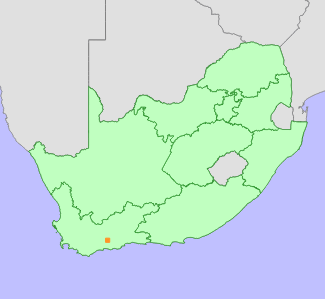|
Scientific Name | Gibbaeum hortenseae (N.E.Br.) Thiede & Klak |
Higher Classification | Dicotyledons |
Family | AIZOACEAE |
Synonyms | Gibbaeum hortenseae (N.E.Br.) Thiede & Klak, Muiria hortenseae N.E.Br. |
Common Names | Muiskopvygie (a) |
National Status |
Status and Criteria | Critically Endangered A2abc; B1ab(iii,v)+2ab(iii,v) |
Assessment Date | 2006/12/01 |
Assessor(s) | J.H. Vlok & D. Raimondo |
Justification | A population reduction of more than 80% is estimated based on habitat loss to road construction in the past 50 years and the observed effects of livestock trampling (generation length 20 years). Only one of five known subpopulations remain (EOO and AOO<1 km²) and mature individuals at this location continue to decline. It is therefore listed as Critically Endangered under criteria A and B. |
Distribution |
Endemism | South African endemic |
Provincial distribution | Western Cape |
Range | This species occurs in the Foothills of the Langeberg Mountains south of Ladismith. |
Habitat and Ecology |
Major system | Terrestrial |
Major habitats | Little Karoo Quartz Vygieveld |
Description | Plants grow in large quartzite patches, on clay soils in succulent karoo on ridges of low hills. |
Threats |
| There has been severe decline of individuals at four of the five subpopulations due to road constructions and trampling (J.Vlok). The Muiskraal road widening and Springfontein farm house road built in the 1960's led to more than 80% of individuals being lost. This locality is well-known to succulent collectors and evidence of illegal collecting can often be seen, this is an ongoing threat. This species is also threatened by intensive grazing practices. J.Vlok has observed severe decline of one subpopulation due to grazing in the past 20 years. |
Population |
Population trend | Decreasing |
Conservation |
| It is not currently conserved in any formally protected area. |
Assessment History |
Taxon assessed |
Status and Criteria |
Citation/Red List version | | Muiria hortenseae N.E.Br. | CR A2abc; B1ab(iii,v)+2ab(iii,v) | Raimondo et al. (2009) | | Muiria hortenseae N.E.Br. | Endangered | Hilton-Taylor (1996) | | Muiria hortenseae N.E.Br. | Endangered | Hall et al. (1980) | |
Bibliography |
Hall, A.V., De Winter, M., De Winter, B. and Van Oosterhout, S.A.M. 1980. Threatened plants of southern Africa. South African National Scienctific Programmes Report 45. CSIR, Pretoria.
Hilton-Taylor, C. 1996. Red data list of southern African plants. Strelitzia 4. South African National Botanical Institute, Pretoria.
Manning, J.C. and Goldblatt, P. 2012. Plants of the Greater Cape Floristic Region 1: The Core Cape Flora. Strelitzia 29. South African National Biodiversity Institute, Pretoria.
Raimondo, D., von Staden, L., Foden, W., Victor, J.E., Helme, N.A., Turner, R.C., Kamundi, D.A. and Manyama, P.A. 2009. Red List of South African Plants. Strelitzia 25. South African National Biodiversity Institute, Pretoria.
|
Citation |
| Vlok, J.H. & Raimondo, D. 2006. Gibbaeum hortenseae (N.E.Br.) Thiede & Klak. National Assessment: Red List of South African Plants version 2024.1. Accessed on 2025/12/03 |
 Comment on this assessment
Comment on this assessment

